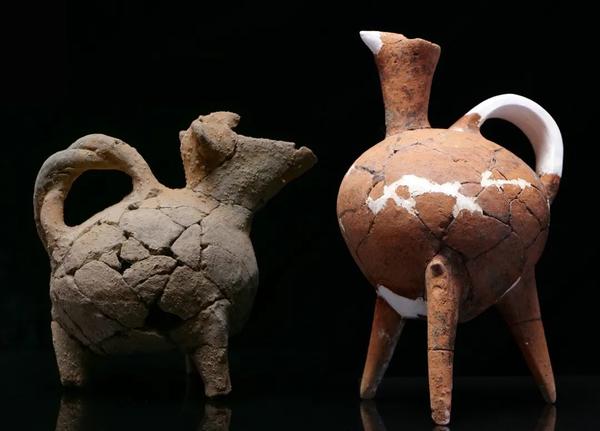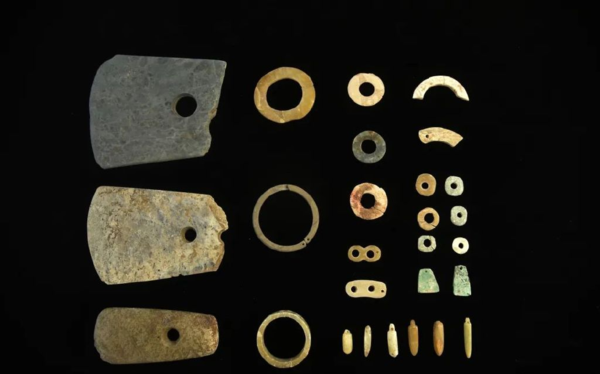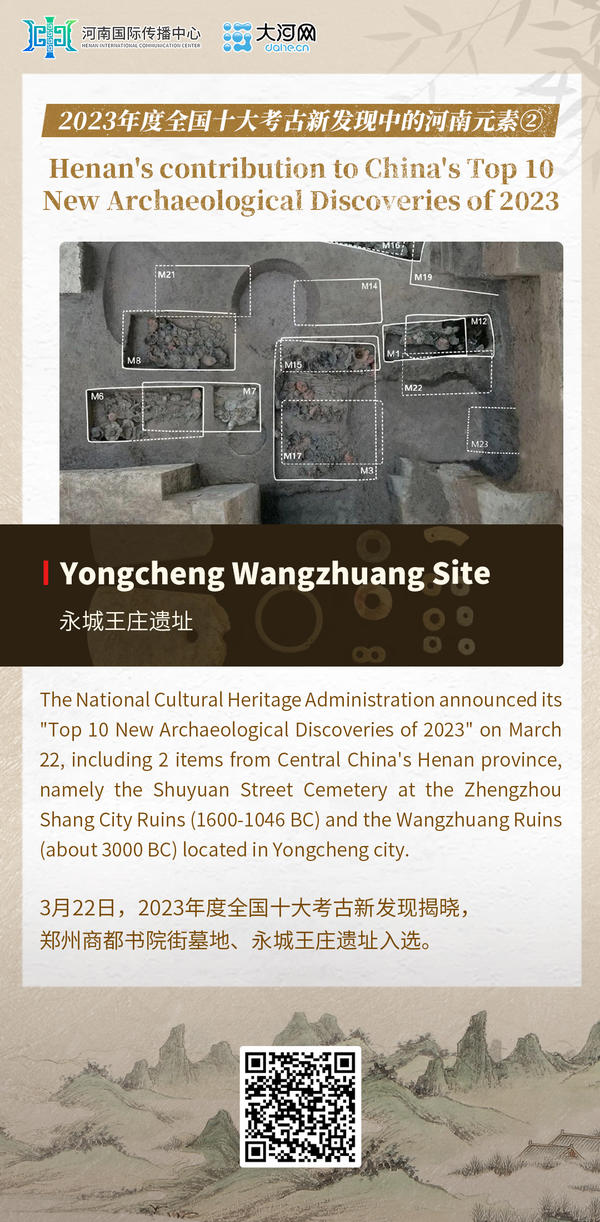The National Cultural Heritage Administration announced its "Top 10 New Archaeological Discoveries of 2023" on March 22, including 2 items from Central China's Henan province, namely the Shuyuan Street Cemetery at the Zhengzhou Shang City Ruins (1600-1046 BC) and the Wangzhuang Ruins (about 3000 BC) located in Yongcheng city.
Yongcheng Wangzhuang Site. [Photo provided to dahe.cn]
In September 2023, high-level tombs were discovered at Wangzhuang Site located on the south bank of the ancient Suihe River in Yongcheng, a county-level city of Shangqiu city, Central China's Henan province. The large-scaled tombs belong to the mid to late period of Dawenkou Culture (4500-2500 BC). According to preliminary calculation, the site is 400 meters long from north to south and 300 meters wide from east to west, with a total area of 120 thousand square meters, which is the largest Neolithic Dawenkou Culture site in East Henan. Besides, the remains of the Longshan Culture period (about 3000-2000 BC) and the dynasties of Shang (1600-1046 BC), Zhou (1046-256 BC), Han (202 BC-206 AD), Tang (618-907), Song (920-1279), Jin (1115-1234) and Yuan(1271-1368) were also discovered, spanning over 5 thousand years. From this perspective, it was one of the earliest Neolithic settlements in Yongcheng.
Pottery wares from Yongcheng Wangzhuang Site. [Photo provided to dahe.cn]
According to Zhu Guanghua, an associate professor at the School of History, Capital Normal University, a large number of cultural relics have been discovered at the Wangzhuang Site, including jade articles, bronze wares, bone implements, stone objects, pottery wares, etc., of which jade articles and painted pottery wares were discovered for the first time from a Neolithic settlement in Yongcheng. Some of the jade wares are exactly the same in material and shape as those unearthed from Gangshang Site (the earliest and largest historical site of Dawenkou Culture discovered so far) in Tengzhou city of East China's Shandong province, while some of them even share the similar features with the objects from the Liangzhu Culture (3300-2300 BC) ruins. It is worth noting that these painted pottery wares have both Yangshao Culture (5000-3000 BC) elements and typical Dawenkou Culture style, which witnessed the integration of eastern and western cultures as well as the exchange of northern and southern cultures in China during prehistoric times. These cultural relics are important materials for studying the origin of Neolithic Culture and Haidai Culture(early Dawenkou Culture) in East Henan, and the fusion of the civilizations of the Yellow River and the Yangtze River.
The discovery of Wangzhuang Site is due to a "Beautiful Village" construction project in Miaoqiao townat the end of 2021. At that time, Wangzhuang village of Miaoqiao town was refurbishing its ponds and pits, while an ancient tomb was found by coincidence on the side of a pit, where a number of jade rings, jade pendants, jade discs, turquoise ornaments, bone arrows, pottery wares were discovered. After preliminary excavation, Wangzhuang Site was approved as a Yongcheng-level cultural relic protection unit. On February 7, 2023, with the approval of the National Cultural Heritage Administration, Capital Normal University, Henan Institute of Cultural Relics and Archaeology, Institute of Archaeology of the Chinese Academy of Social Sciences, and Shangqiu Institute of Cultural Relics and Archaeology jointly carried out official excavations at Wangzhuang Site.
Yongcheng Wangzhuang Site. [Photo provided to dahe.cn]
"In 2023, the ring trench outside the site we have identified is generally oval in shape and over 10 meters in width, which is about 5 meters from the ground. Besides, from the high-level tombs in the No. 4 archaeological zone, a large number of cultural relics have been discovered, including jade articles, turquoise ornaments, stonegui(an elongated pointed tablet held in the hands by ancient rulers on ceremonial occasions), etc." According to Zhu Guanghua, the archaeological team leader, the discovery of a large number of stoneguiand other artifacts of ritual significance indicates that the settlement of Wangzhuang Site is of high grade and is likely to be a local central settlement. The stratification and superposition of the tombs indicate that the site was used for a long time, roughly belonging to the middle and late period of Dawenkou Culture. The tombs of different shapes and structures with different numbers of funerary objects could be a hint that there was a clear social hierarchy at that time. Judging from the types and styles of artifacts that have been restored, Wangzhuang Site was influenced by the Haidai culture in its east and the Central Plain culture in its west, suggesting that it was a witness of the convergence of China's eastern and western culture.
Text: Zhao Hanqing & Yang Jiaxin
Poster: Hu Hanze
Proofreader: Chen Xingjie






